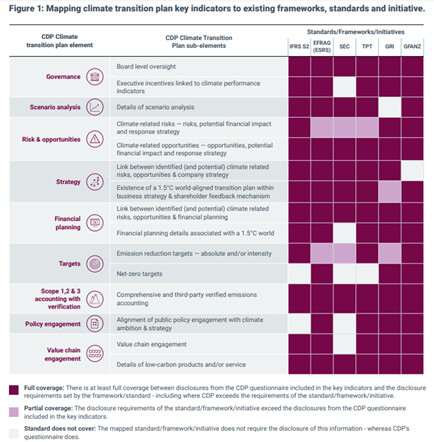Insights into climate transition plans

A climate transition plan is a detailed roadmap that defines how to adapt your assets, operations, and business model to achieve net-zero by 2050. It captures risks, goals and actions related to an organisation’s transition towards a lower carbon economy.
Climate transition plans are a relatively new concept and are progressing rapidly. Disclosures on climate transition plan are now required by several different standards including the IFRS S2, which is developed by the International Sustainability Standards Board (ISSB), and the European Sustainability Reporting Standards (ESRS) under the Corporate Sustainability Reporting Directive (CSRD).
CDP, another disclosure framework and one of the most used and credible platforms for environmental disclosures, has included climate transition plans in their questionnaire since 2021. They have seen a sharp increase in the number of companies disclosing a climate transition plan. In 2024, over one in four companies disclosed that they have a 1.5°C-aligned climate transition plan in place, which was an increase of 44% compared to the year before. However, only 2% of the companies that report having a climate transition plan are disclosing all 21 indicators to judge credibility. The main challenges include comprehensive strategy development, target setting, and financial planning.
Why do you need a climate transition plan?
On the one hand a climate transition plan sets out how your company will align with global climate goals and meet reporting requirements, one the other it is a strategic requirement to ensure long-term success in the transition to a lower carbon economy. It will help you understand the transition risks and opportunities your company will encounter, assess how you need to transform to adapt to these risks and to capitalise on the opportunities. It provides insights into the financial consequences of the transition. Having a transition plan will also make is easier to communicate what you are doing in relation to climate change to stakeholders.
What framework should you use?
As briefly mentioned before, there are several different frameworks, standards, and initiatives around what elements a climate transition plan should have. The expectations of what constitutes a credible climate transition plan are increasingly converging. Below is a mapping done by CDP of what elements are covered by what framework, standard, and initiative.

Source: CDP, The State of Play 2023 Climate Transition Plan Disclosure (June 2024), p. 7
Our view is that the Transition Plan Taskforce (TPT) disclosure framework is the best to use. First, because the TPT has been globally adopted through the IFRS Foundation, which has now assumed the responsibility of the TPT, and because it builds on the work carried out by the Glasgow Finance Alliance for Net Zero (GFANZ)[1]. Second, because it provides a clear structure based on three As: ambition, action, and accountability.
The TPT will also help you prepare for the disclosures under the ESRS. In October 2023, the TPT published a comparison between the TPT disclosures and the ESRS disclosures. The European Financial Reporting Advisory Group (EFRAG) is planning to do the same in the coming year.
EFRAG’s guidance on transition plans is currently being developed. A draft version of the guidance was published in November 2024, with a final version expected during the course of 2025. Overall, the guidance is similar to TPT requiring the same building blocks. The only main difference is that the ESRS requires you to communicate a net-zero target. Below we have summarised the five most important takeaways from EFRAG’s draft implementation guidance:
- Establishing a GHG baseline is fundamental
Disclosing greenhouse gas (GHG) emissions is a foundational step for any transition plan. Companies must account for and report their GHG emissions to set a baseline for future targets and to monitor progress. - Setting GHG reduction targets
Following the calculation of GHG emissions, companies should define and disclose their reduction targets. This forward-looking information reflects their ambition in reducing emissions and is critical for establishing a clear climate action pathway. [CS1] This could for example be done through validation of targets with the Science Based Targets initiative (SBTi). - Planning for actions
The transition plan must articulate the decarbonisation levers and planned actions that contribute to bridging the gap between the current emissions baseline and future targets. - Investments and performance Indicators
The guidance emphasises the need for companies to quantify their investments and funding related to the transition plan. This is expected to ensure that the planned actions are properly resourced and auditable, and that the reductions have a reasonable likelihood of being achieved. The capital expenditures (CapEx) and operational expenditures (OpEx) needed should be linked to specific decarbonisation levers. There is a connection here to the EU Taxonomy disclosures, as these can cover actions the company is taking. - Strategic integration and continuous reporting
Organisations should integrate their transition plans within their broader business strategy and model, providing a narrative on how they intend to create value while transitioning to a sustainable economy. In the ESRS this is for example done with the disclosure requirement E1.SBM-1 where the company describes the resilience of, including the ability to adjust or adapt, its strategy and business model to climate change.
For more insights and support in developing your climate transition plan, please reach out to Nishant Parekh and Anna Tranberg.
Next to climate transition plans, nature transition plans are also gaining traction. They examine and explain how companies will adapt to align with global goals for biodiversity conservation and ecosystem restoration. We will explore this in a future article, so make sure to follow us on LinkedIn.
-----
[1] The Glasgow Financial Alliance for Net Zero is a group formed during the COP26 climate conference in Glasgow bringing together financial institutions and other financial services sector participants, GFANZ has developed a global transition plan framework to support firms undertaking transition planning.
Link to our service "Strategy on Climate for businesses".

